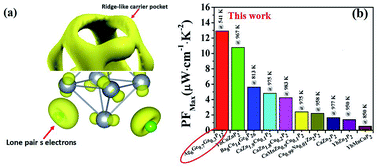High thermoelectric performance in complex phosphides enabled by stereochemically active lone pair electrons†
Abstract
We propose a new strategy to design high performance thermoelectric materials with stereochemically active lone pair electrons. This novel concept is experimentally demonstrated in the cluster compounds Ag6Ge10(1−x)Ga10xP12 with x = 0.0, 0.01, 0.03, 0.04. A maximum power factor of 13 μW cm−1 K−2 is achieved after optimizing carrier concentration. Density functional theory calculations reveal that the stereochemically active lone pair electrons from s orbitals of Ge give rise to a peak in the density of states near the valence band maximum, a feature that is beneficial for achieving a high power factor. Experimental results also confirm the theoretically predicted relatively low thermal conductivity of about 1 W m−1 K−1 arising from the rattling vibrations associated with Ag6 clusters, which create low-frequency localized optical phonons in the acoustic region and thus enable strong anharmonic phonon scattering. The highest zT value attained here is 0.65 at 723 K for the x = 0.03 sample, a record high value for polycrystalline phosphide and still with significant potential for optimization.



 Please wait while we load your content...
Please wait while we load your content...
